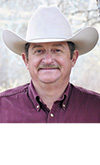Producers failing to adjust their management and nutrition program to the weather may have cows that calve in poor body condition, produce weak calves and fail to breed back. In addition, calves that are born into cold or wet weather conditions have a reduced chance of survival.
Effects on cows
Cold, wet snow and wind, alone or together, can create weather stress on cows. Lower critical temperature (LCT) is the temperature below which an animal must burn extra energy to keep warm.
For example, the LCT for Idaho cows with heavy dry winter coats is about 18ºF, but the LCT of wet cows is 59ºF (Table 1). If the energy is not supplied as extra nutrition, then cows will burn fat and lose weight to keep warm.
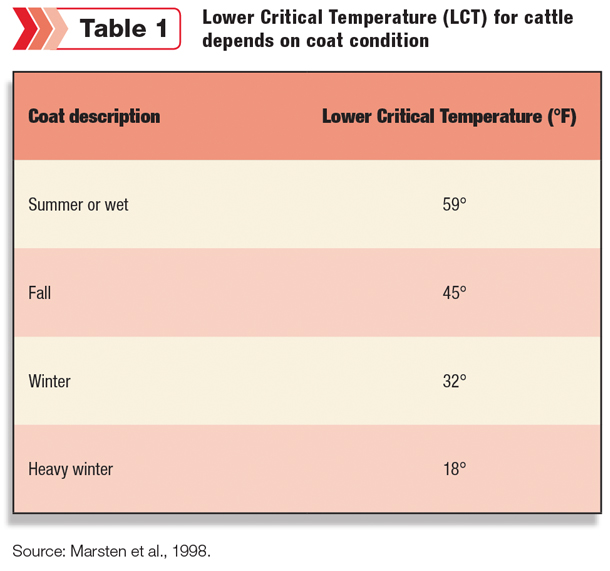
Cows that lose weight during late gestation and calve in low (BCS 4) to thin (BCS 2 or 3) body condition will have lower pregnancy rates this spring. Thin cows also produce weak calves that have a reduced chance of survival.
Research from Colorado State indicates that first-calf heifers calving in body condition score of 4 or less produce colostrum with reduced antibody levels. Calves from these undernourished heifers were more likely to become sick than calves from well-fed heifers.
An increase in wind chill or wet weather can dramatically increase the cold stress on cows. Table 2 shows the wind chill temperatures for cattle with dry winter coats.
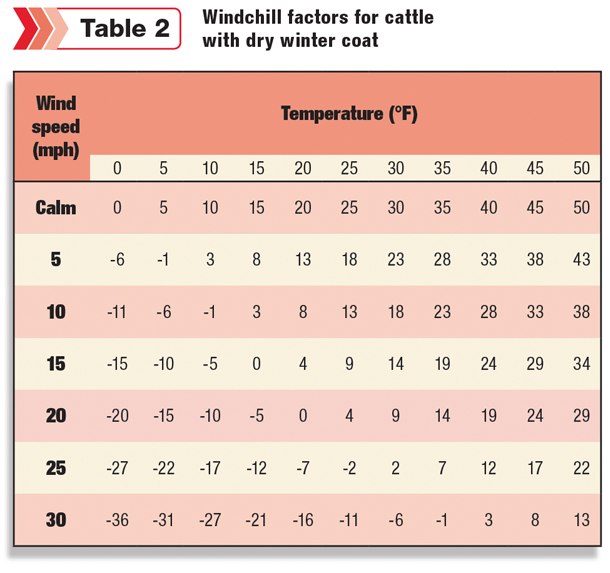
Even within states, weather stress will vary greatly. As an example, Table 3 indicates the general average temperatures and wind speed in areas of Idaho during January, February and March.
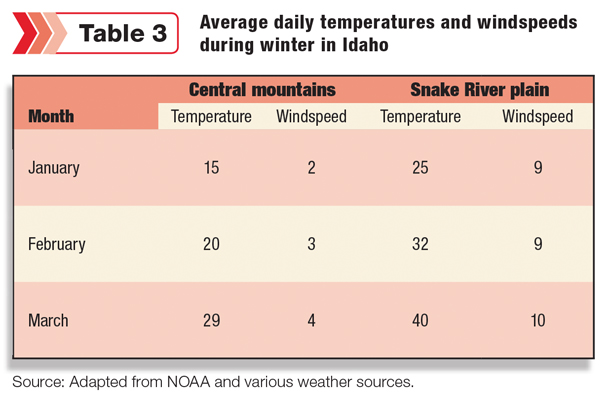
Based on these averages, cows with heavy coats in the Central Mountains are experiencing mild cold stress in January and February, whereas cows in the Snake River Plain are only stressed in January.
What is the magnitude of cold stress in this example in normal years? Windchill temperatures are 5 to 20ºF below LCT for cows with dry winter coats. For cows with wet coats, the wind chill temperatures can easily be 20 to 30ºF below LCT.
Charting a forecast
Producers should use their monthly and weekly averages for their location to plan winter feeding and management programs. The Western Regional Climate Center is a good resource to obtain data on average for a specific location in the West.
Remember to use the average daily temperature, not the average low temperature. In addition to planning for normal winter conditions, producers must be ready to adapt management and feeding programs for unusually cold, wet or windy weather.
An occasional windy night or extremely cold day may not be cause for major changes in management; however, when conditions deteriorate for several days, ranchers should adapt their feeding and management programs.
Research from Kansas and Iowa indicates that maintenance energy requirements of the cow increase by 1 percent for each degree below the LCT (Table 4).
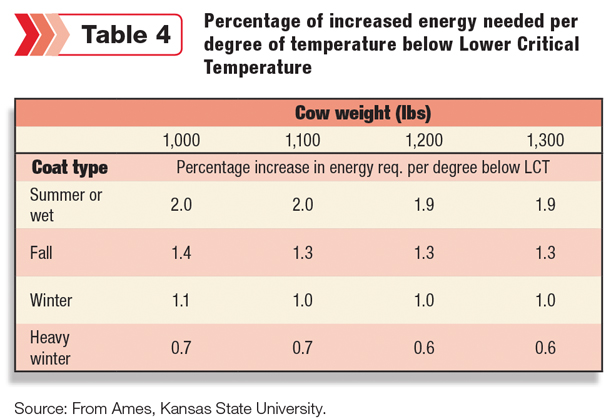
For wet cows, the rule of thumb is 2 percent for every degree below LCT. Use the wind chill chart to estimate the wind chill-adjusted temperature for a period of time. For example, an area with an average January temperature of 15ºF and wind speed of 5 mph would have an adjusted temperature of 8ºF.
So for cows with heavy winter coats, their energy requirements in January, in this example, are 10 to 20 percent above what is expected. Periods with high winds, snow or rain increase energy requirements and could result in increasing the requirement 20 to 25 percent above expected.
So how does this change how producers should feed cows? In the above example, during January and February conditions, cows will need an additional 3 to 4 pounds of hay or 2 to 2.5 pounds of grain.
For all practical purposes, producers can feed more hay to compensate for weather stress. However, if hay is low in energy, then 2 to 2.5 pounds of grain should be fed per cow. Hays that are low in protein will need to be supplemented with 1 to 2 pounds of protein. Cows that do not receive extra energy will lose 0.5 to 1 pound per day.
In extremely cold or wet conditions, cows will need to eat 7 to 8 more pounds of hay or 4 to 5 pounds of grain or high-energy byproducts (i.e., distillers grain). In most cases, cows will not be able to eat another 8 pounds of hay per day unless hay is very good-quality.
In these extreme weather cases, cows should be fed the additional grain during the period of cold stress. Cows that are not fed additional energy can lose 1.5 to 2 pounds per day during extreme conditions.
It is important that ranchers understand the conditions in their area and adapt their feeding programs to fit their situations. Consult an extension professional or a beef cattle nutritionist for assistance with developing a cost-effective strategy for each operation. Addition of windbreaks in pastures and lots will decrease the supplemental feed needed.
Even if cows have lost weight during extreme cold-stress periods, it is not too late to increase energy intake so cows gain weight. Usually feeding 3 to 5 pounds of grain or high-energy byproducts for several weeks will help cows recover lost weight.
Effects on calves
Cold stress has more lethal consequences on calves than cows. Newborn calves are the most susceptible cattle to cold stress. Calves less than 2 weeks old and sick calves are also at risk.
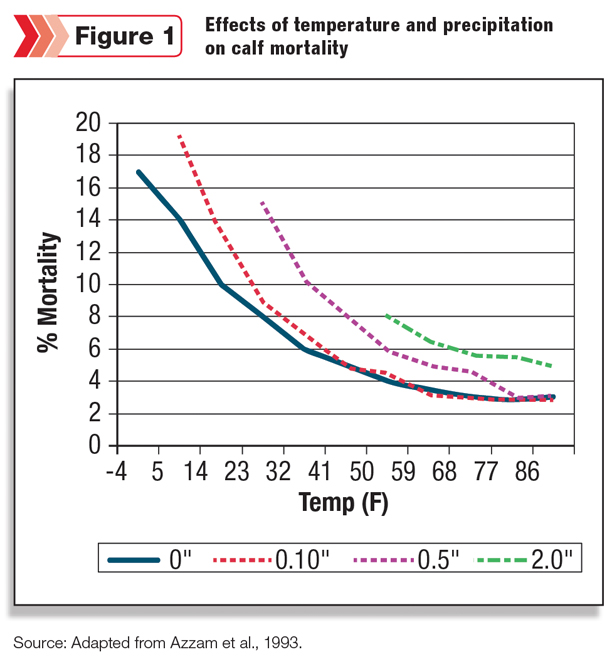
Figure 1 illustrates the dramatic effect cold and precipitation has on calf survival. The LCT for calves is closer to 60ºF with calf mortality increasing exponentially as temperatures move below 50ºF. Add a little rain or snow, and the LCT moves closer to 70ºF.
As little as 0.1 inch of rain on the day the calf is born can increase calf losses by 2 to 4 percent.
Strategies to reduce this stress start with keeping the cows well fed and in good body condition. Cows that calve in good body condition (BCS 5 to 6) have stronger calves with greater energy reserves.
These cows are also less likely to run out of energy during calving and will be up drying off the calf sooner than underfed cows.
Extra diligence in checking cows for signs of calving during extreme weather conditions is also important. Calves need to nurse within two to four hours of birth or sooner during cold or wet conditions. Feeding cold-stressed calves 2 quarts of warm colostrum with an esophageal feeder (calf tube feeder) will help reduce calf losses and give calves enough energy to nurse on their own.
A clean, well-drained calving location with windbreaks will help decrease the impacts of poor weather on calves. In some cases, cows and calves may need to be moved to sheds or barns for the first day or two of the calf’s life.
However, cows and calves should be moved to pastures as soon as the calf is strong and eating well, usually one to two days after calving. Due to health considerations, cows should be calved out on clean pastures whenever possible; calving in barns should be used only as needed.
Commercial calf blankets, such as the Woolover blanket, can increase calf survivability and gain. Research from North Dakota State demonstrated a 0.3-pound increase in average daily gain for beef calves wearing blankets for the first three weeks of life. Having enough blankets for all calves would be cost-prohibitive, but putting these blankets on weak or chilled calves for a few days while they are in the calving or maternity barn may help calf survival.
Dealing with cold-weather stress sometimes means more management than just “keeping their bellies full,” but producers that stay on top of weather conditions and adjust their management accordingly will be rewarded with healthier calves and more pregnant cows.
References omitted due to space but are available upon request. Click here to email an editor.

-
John B. Hall
- Extension Beef Cattle Specialist
- University of Idaho
- Email John B. Hall
